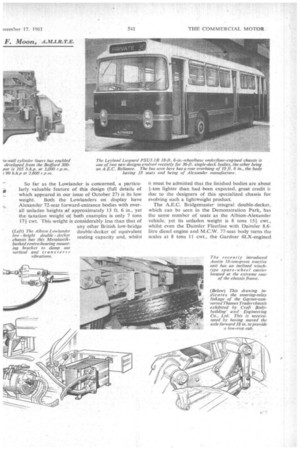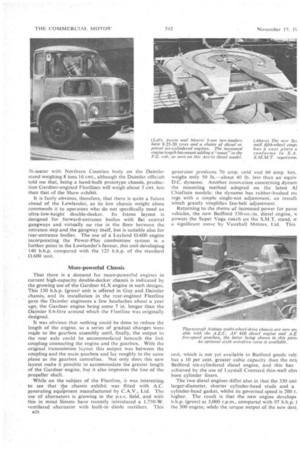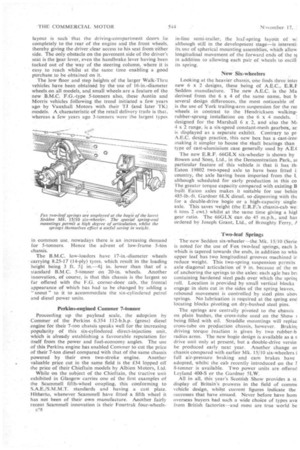Glasgow Reveals British Superiority
Page 58

Page 59

Page 60

Page 61

Page 62

If you've noticed an error in this article please click here to report it so we can fix it.
FORTY-THIRD SCOTTISH EXHIBITION SHOWS BRITAIN TO BE LEADING THE CONTINENT IN CHASSIS DESIGN
HAVING visited four Continental commercial-vehicle exhibitions this year—the Belgian, Swiss, German and Italian Shows—I feel able to state without fear of contradiction that the 1961 Scottish Motor Exhibition, which closes tomorrow, provides by far the greatest number of new and advanced designs that has been featured at any European show this year. Thus, to my mind, the Scottish Show reflects the continued progress of British vehicle manufacturers: progress not only in the design sense, but also in respect of home and overseas sales. Indeed, when the Show opened last Friday it was revealed that Britain had exported over 130,000 vehicles in the first nine months of this year, the value of these exports being more than £94 m.
Every Show has its surprises, and this year's Scottish provided two—the first public showing of the new Bedford 330-cu.-in, diesel engine, and the appearance in the Demonstration Park of an E.R.F. 66GXL six-wheeler with a new high-capacity Eaton two-speed axle. In addition to these two unexpected novelties, though, there were several new designs officially revealed to the public for the first time on the Show opening day, including the B.M.C. 1.5litre diesel engine, a low-loading 5-tonner from the same concern, the world premier of the French Renault 6-cwt. van and a novel Seddon tWin-spring bogie embodying Fox two-leaf springs. _ British 36400ters Despite the many interesting new and recently introduced goods-vehicle designs, I think it is fair to say that passenger vehicles are the stars of this Show, particularly the A.E.C. and Leyland 36-ft. single-deckers and the Albion Lowlander low-height double-decker. This is the first public Show at which British single-deckers built for use in this country to the new box dimensions of 36 ft. by 8 ft. 21 in. have been featured, and whilst in the case of all the vehicles on display the chassis themselves reveal no great technical novelties, being merely quite straightforward lengthened versions of existing 30-ft. designs (except that the A.E.C. Reliance is offered with a more powerful engine), it is encouraging to see that both Alexander and Duple have produced extremely attractive and well-balanced bodies for these two new chassis.
So far as the Lowlander is concerned, a particularly valuable feature of this design (full details of which appeared in our issue of October 27) is its low
weight. Both the Lowlanders on display have Alexander 72-seat forward-entrance bodies with overall unladen heights of approximately 13 ft. 6 in., yet the taxation weight of both examples is only 7 tons 17+ cwt. This weight is considerably less than that of any other British low-bridge double-decker of equivalent seating capacity and, whilst
it must be admitted that the finished bodies are about +-ton lighter than. had -been expected, great credit is due to the designers of this specialized chassis for evolving such a lightweight product.
The A.E.C. Bridgemaster integral double-decker, which can be seen in the Demonstration Park, has the same number of seats as the Albion-Alexander vehicle, yet its unladen weight is 8 tons 15+ cwt., whilst even the Daimler Fleedine with Daimler 8.6litre diesel engine and M.C.W. 77-scat body turns the scales at 8 tons 11 cwt., the Gardner 6LX-engined
76-seater with Northern Counties body on the Daimler stand weighing 8 tons 16 cwt,, although the Daimler officials told me that, being a hand-built prototype chassis, production Gardner-engined Eleetlines will weigh about 3 cwt. less than that of the Show exhibit.
It is fairly obvious, therefore, that there is quite a future ahead of the Lowlander, as its low chassis weight alone commends it to operators who do not specifically need an ultra-low-height double-decker. Its frame layout is designed for forward-entrance bodies with flat central gangways and virtually no rise in the floor between the entrance step and the gangway itself, but is suitable also for rear-entrance bodies. The use of a Leyland 0.600 engine incorporating the Power-Plus combustion system is a further point in the Lowlander's favour, this unit developing 140 b.h.p. compared with the 125 b.h.p. of the standard 0.600 unit.
More-powerful Chassis
That there is a demand for more-powerful engines in current high-capacity double-decker chassis is indicated by the growing use of the Gardner 6LX engine in such designs. This 150 b.h.p. (gross) unit is offered in Guy and Daimler chassis, and its installation in the rear-engined Fleetline gave the Daimler engineers a few headaches about a year ago, the Gardner engine being some 7 in. longer than the Daimler 8.6-litre around which the Fleetline was originally designed.
It was obvious that nothing could be done to reduce the length of the engine, so a series of gradual changes were made to the gearbox assembly until, finally, the output to the rear axle could be accommodated beneath the link coupling connecting the engine and the gearbox. With the original transmission layout this output was between the coupling and the main gearbox and lay roughly in the same plane as the gearbox centreline. Not only does this new layout make it possible to accommodate the greater length of the Gardner engine, but it also improves the line of the propeller shaft.
While on the subject of the Fleetline, it was interesting to see that the chassis exhibit was fitted with A.C. generating equipment manufactured by C.A.V., Ltd. The use of alternators is growing in the p.s.v. field, and with this in mind Simms have recently introduced a 1,750-W. ventilated alternator with built-in diode rectifiers. This B26 generator produces 70 amp. cold and 60 amp. hot, weighs only 50 lb.—about 40 lb. less than an equiv. D.C. dynamo. Another innovation concerning dynam the mounting method adopted on the latest Al Chieftain models: the dynamo has rubber-bushed tric ings with a simple single-nut adjustment, an installt which greatly simplifies fan-belt adjustment.
Returning to the theme of increased power for passe vehicles, the new Bedford 330-cu.-in, diesel engine, vs powers the Super Vega coach on the S.M.T. stand, na significant move by Vauxhall Motors, Ltd. This
unit, which is not yet available in Bedford goods vehi has a 10 per cent. greater cubic capacity than the oril Bedford six-cylindered diesel engine, and this has achieved by the use of Laystall Cromard thin-wall chrt bore cylinder liners.
The two diesel engines differ also in that the 330 unii larger-diameter, shorter cylinder-head studs and a cylinder-head gasket, whilst its governed speed is 200 r. higher. The result is that the new engine develops b.h.p. (gross) at 3,000 r.p.m., compared with 97 b.h.p. I the 300 engine, while the torque output of the new desi;
.-ft. at: 1,800 r.p.m as opposed. to 217 lb.-ft. at 1,400 In additton to the advantage of the increased power, life should be vastly improved by the use of these ard liners..
of that goods-vehicle design has by no means stood year is given by the remarkable number of goods Is exhibited for the firsttime, These range from the kenault van to the A.E.C. Marshall 20-ton-gross 6 x 2 overing most of the popular intermediate sizes. The sIt 6-cwt. van was fully described in our last issue, [though imports from France are not due to start until -1 of next year, already considerable interest has been in this design.
Fourgon, as it is called, has several clever features. le least of which is its all-independent suspension endows it with a truly amazing rough-road perforfot farm tracks and other types of unmade Its suitability for use in country districts is further sized by the elimination of the chassis greasing and the incorporation of a sealed cooling system should never need topping up. Although no price Nt been fixed for the Fourgon it is known that it will above £450, with a distinct possibility that it will be r £400 than .£450.
LC. announced a brand-new 1.5-litre diesel engine on pening day of the Show, and this neat little unit is made available in Austin and Morris 10/12-cwt. and 16/18-cwt. light commercials. The Corporation thus becomes the first British concern to manufacture an engine of this size for its own vehicles; the Perkins 4.99 42-b.h.p. 1.62-litre diesel is offered in Bedford, Cornmer and Thames vans. The new B.M.C. engine is based on the B-Series petrol engine, and it produces 40 b.h.p. at 4,000 r.p.m., which is only 2 b.h.p. less than the commercial-vehiele B-Series unit.
K.L.G. Heater Plugs
It has Ricardo Comet Mk. 5 combustion chambers and a compression ratio of 23 to 1, and cold-starting difficulties should be obviated by the use of a new type of K.L.G. sheathed-element heater plug, the small diameter of which has made it possible to increase the size of the cylinderhead water passages in the immediate area of the pre-combustion chambers. It will be interesting to see how many B.M.C. vehicles are ordered with this new diesel unit: after a promising start, some of the other van manufacturers who offer diesel engines seem to be of the opinion that the demand for diesel has started to wane slightly.
Another new small diesel is that developed by the Rover Co., Ltd., as an optional unit for their Land-Rover models. This is a 2,1litre unit, based on the existing.21-litre fourcylindered petrol engine, and producing 10 b.h.p. more than the original Rover 2-litre diesel. lt is interesting to note that both the B.M.C. and Rover diesels are derived from petrol engines. This has considerable production advantages, which should result in keeping manufacturing costs down, One of the most imaginative delivery-vehicle designs to have been evolved in recent years is the Comrner WalkThru series, several examples of which are displayed in Glasgow. The Walk-Thru range consists of 14-, and 3-ton chassis, the 11and 2-ton models being available with capacious slab-sided van bodies. The design of the WalkThru chassis is relatively conventional and simple, but its
layout is such that the driving-compartment doors lie completely to the rear of the engine and the front wheels, thereby giving the driver clear access to his seat from-either side. The only obstacle on the pavement side of the driver's seat is the hear lever, even the handbrake lever having been tucked out of the way of the steering column, where it is easy to reach whilst • at the same time enabling a good purchase to be obtained on it.
The low floor and step heights of the larger Walk-Thru vehicles have been obtained by the use of 16-in.-diameter wheels on all models, and small wheels are a feature of the new B.M.C. F.G.-type 5-tormers also, these Austin and Morris vehicles following the trend initiated a few years ago by Vauxhall Motors with their TJ (and later TK) models. A characteristic of the retail delivery trade is that. whereas a few years ago 3-tonners were the largest types in common use, nowadays there is an increasing demand for 5-tonners. Hence the advent of low-frame 5-ton chassis.
The B.M.C. low-loaders have 17-in.-diameter wheels carrying 8.25-17 (14-ply) tyres, which result in the loading height being 3 ft. 5}1 in.—ft in. lower than that of a standard B.M.C. 5-tonner on 20-in. wheels. Another innovation, of course, is that this chassis is the largest so far offered with the E.G. corner-door cab, the frontal appearance of which has had to be changed by adding a " snout " to it to accommodate the six-cylindered petrol and diesel power units.
Perkins-engined Conliner 7-tonner
Proceeding up the payload scale, the adoption by Commer of the Perkins 6.354 I12-b.h.p. (gross) diesel _engine for their 7-ton chassis speaks well for the increasing popularity of this six-cylindered direct-injection unit. which is already establishing a favourable reputation for itself from the power and fuel-economy angles. The use of this Perkins engine has enabled Comrner to cut the price of their 7-ton diesel compared with that of the same chassis powered by their own two-stroke engine. Another valuable price cut in the same field is the £34 lopped off the price of their Chieftain models by Albion Motors, Ltd.
While on the subject of the Chieftain, the tractive unit exhibited in Glasgow carries one of the first examples of the Scammell fifth-wheel coupling, this conforming to S.A.E./S.M.M.T. standards and having a cast plate. Hitherto, whenever Scammell have fitted a fifth wheel it has not been of their own manufacture. Another fairly recent Scammell innovation is their Fourtrak four-wheelsal 8 in-line semi-trailer, the leaf-spring layout of wl although still in the development stage—is interestii its use of spherical mounting assemblies, which allow longitudinal movement of the forward ends of the si in addition to allowing each pair of wheels to oscill its spring.
New Siv-wheelers Looking at the heavier chassis, one finds three inter new 6 x 2 designs, these being of A.E.C., E.R.I Seddon manufacture. The new A.E.C. is the Ma derived from the 6 x 4 of the same name, but b several design differences, the most noticeable of is the use of York trailing-arm suspension for the rea wheels in contrast to the Hendrickson walkingrubber-sprung installation on the 6 x 4 models. 1 designed for the Marshall 6 x 2, and also the MI 4 x 2 range, is a six-speed constant-mesh gearbox, at is displayed as a separate exhibit. Contrary to pr, A.E.C. design practice, this new box has a cast-iron making it simpler to house the shaft bearings than type of cast-aluminium case generally used by AE.( The new E.R.F. 66GLX six-wheeler is shown by Bowen and Sons, Ltd„ in the Demonstration Park, al particular feature of this vehicle is that it has th, Eaton 19802 two-speed axle to have been fitted i country, the axle having been imported from the L although scheduled for early production in this co The greater torque capacity compared with existing B built Eaton axles makes it suitable for use behin 485-lb.-ft. Gardner 6LX diesel, so dispensing with tht for a double-drive bogie or a high-capacity single axle. This saves weight (the E.R.F.'s chassis-cab wei 6 tons 2 cwt.) whilst at the same time giving a higl gear ratio. The 66GLX can do 45 m.p.h., and has ordered by Joseph Grant, Ltd., of Broughty Ferry, Two-leaf Springs • The new Seddon six-wheeler—the Mk. 15/10 (Serie is noted for the use of Fox two-leaf springs, each 1( which is tapered towards the ends, in addition to whi( upper leaf has two longitudinal grooves machined ir reduce weight. This two-spring suspension permits axle diagonal articulation of 9 in. because of the m of anchoring the springs to the axles: each aide has bi-: containing hardened steel pads over which the sprint roll. Location is provided by small vertical blocks engage in slots cut in the sides of the spring leaves, rebound movement is controlled by steel pins alum springs. No lubrication is required at the spring end locating blocks pivoting on dry-bushed steel pins.
The springs are centrally pivoted to the chassis on plain bushes, the cross-tube used on the Show / being filled with oil. Straddle mountings will replac cross-tube on production chassis, however. Brakim driving torque reaction is given by two rubber-b radius arms. The new bogie design is available as a s drive unit only at present, but a double-drive versio: be produced early next year. Another change or chassis compared with earlier Mk. 15/10 six-wheelers i full air-pressure braking and cam brakes have adopted, whilst the cab recently introduced on the r 8-tonner is available. Two power units are offered Leyland 400-S or the Gardner 5LW.
All in all, this year's Scottish Show provides a st display of Britain's prowess in the field of commt vehicle design, whilst current figures indicate the successes that have ensued. Never before have horn overseas buyers had such a wide choice of types ava from British factories—and most are true world be




















































































































